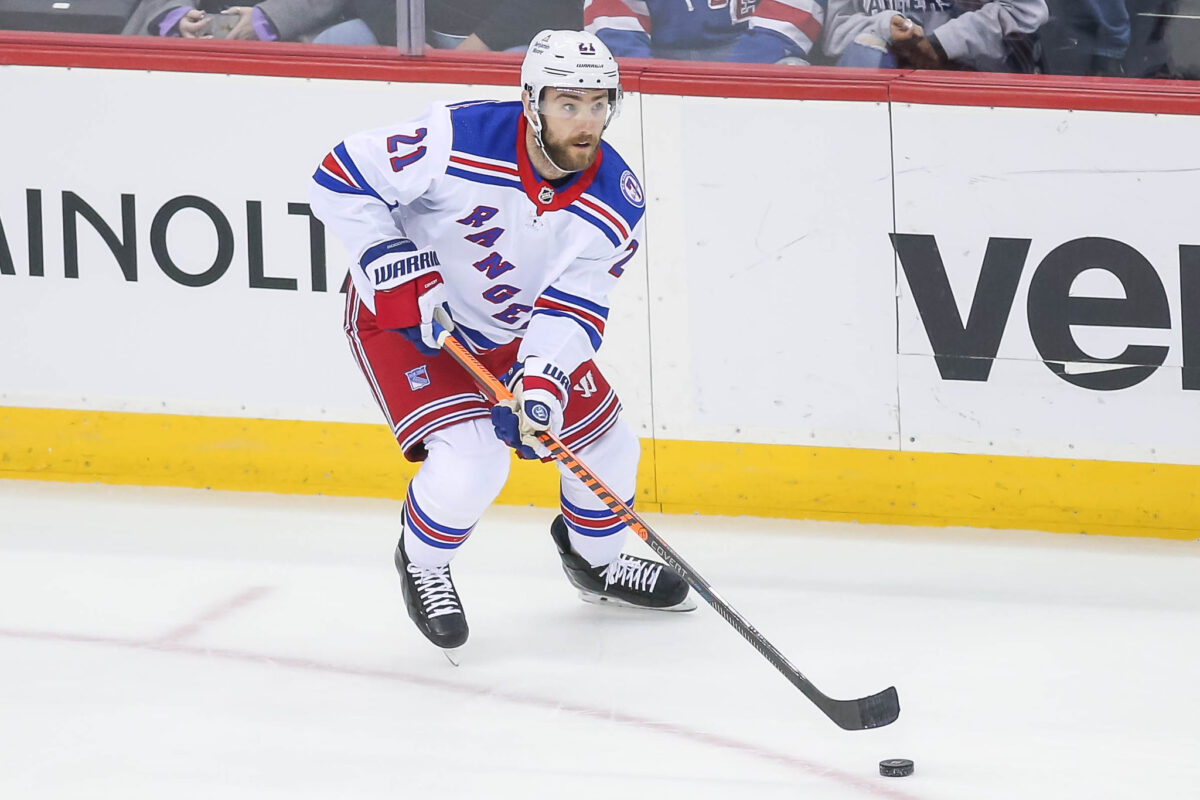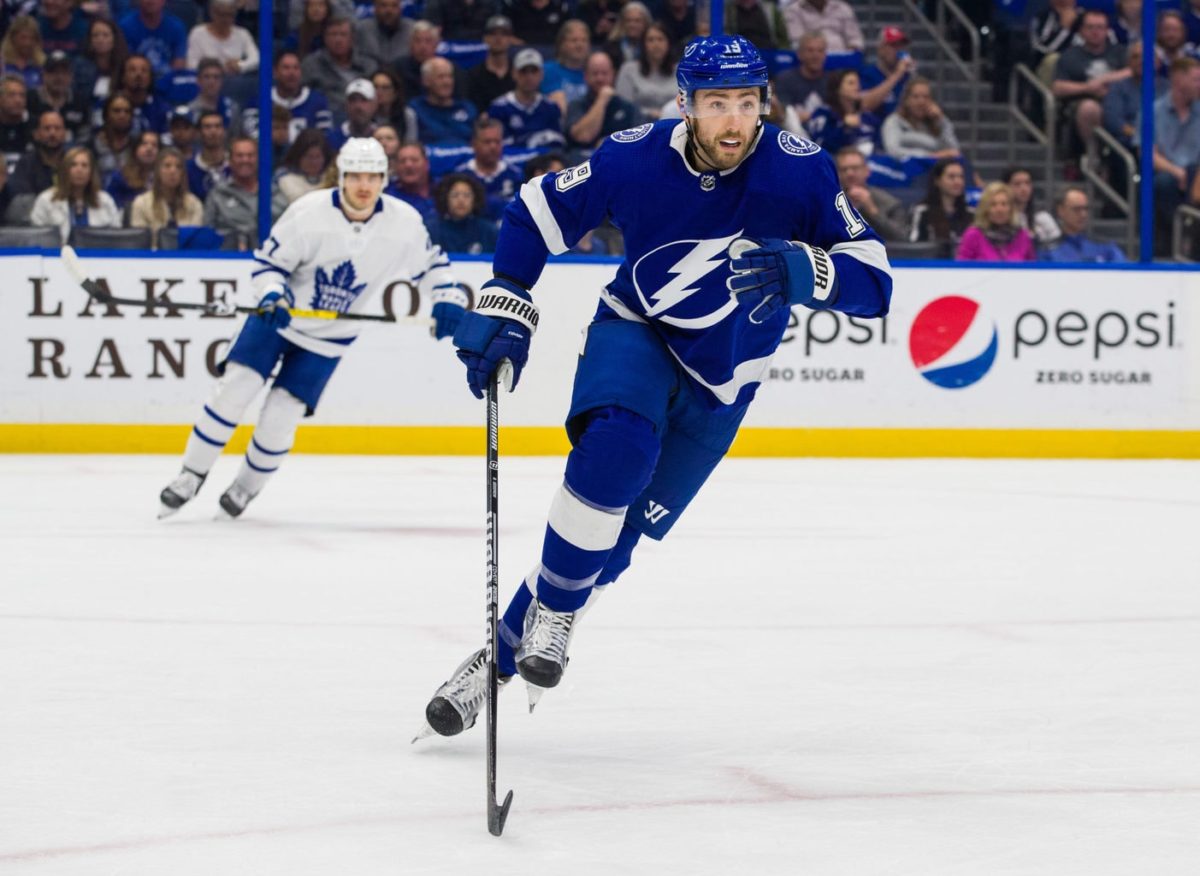Though it’s probably unlikely that the New York Rangers‘ 4-3 victory over the Detroit Red Wings on April 5 ends up being a first-round playoff preview, the Blueshirts had to be encouraged by a performance that they’ll need to duplicate at times to win in a postseason tournament that’s less than two weeks away.
All the more promising was the fact that no player was more integral to earning the two points than Barclay Goodrow.
The Rangers can only hope that the snarling, big-goal scoring version of their veteran forward – exactly the version that compelled general manager Chris Drury to give the 31-year-old an onerous contract that’s not aging well – is the one who sticks around into the spring.

That’s because the kind of victory that the Blueshirts clawed out in the Motor City has a much better chance of being repeated in the playoffs if Goodrow can turn back the clock like he did against the Red Wings, a fading but desperate team battling for the second wild-card spot in the Eastern Conference – the winner of which could be the Rangers’ opening opponent.
Lightning Form of Goodrow Re-Emerged Against Red Wings
Goodrow scored two goals, won six of 10 faceoffs, had a fight with Detroit’s Robby Fabbri that wasn’t penalized as such and engaged in healthy doses of yapping and getting up in Red Wings’ faces. The glue guy for back-to-back Stanley Cup champions with the Tampa Bay Lightning, the player the Rangers thought they were getting three years ago, finally showed up in what’s been an otherwise forgettable season for him.
His second goal, which tied the game at 3 just 25 seconds after Dylan Larkin gave Detroit the lead in the second period, was only his fourth of the season. With 12 points, a minus-11 rating and terrible underlying metrics, Goodrow’s six-year, $21.8 million deal that has three years left to run after this season has been the primary topic of conversation surrounding a player who has frankly looked finished at times this season.
There seems little chance Goodrow will finish out that contract in New York. For the present and short-term future, though, he has a chance to be the impact player he was brought in to be as the Blueshirts work to secure the Presidents’ Trophy and make a deep playoff run.
Related: 3 Reasons the Rangers Will Have More Playoff Success This Year
“He’s a blood-and-guts type of guy,” coach Peter Laviolette said. “You need those guys in your lineup, and so it’s nice to see him have a night like that and have a really big night offensively.”
Despite Laviolette’s praise, it’s no secret that he doesn’t value Goodrow as much as his predecessor did. Goodrow was Gerard Gallant’s Swiss Army knife for two seasons, with the former coach always at the ready to move Goodrow up in the lineup, feeling that he made any line he played on better. That was reflected in Goodrow’s production over the previous two seasons, during which he recorded 24 goals, 40 assists and a plus-16 rating while playing all but three games. With Tampa, Goodrow played on a consequential shutdown third line, averaging better than 17 minutes in the 2020 and 2021 playoffs, both of which ended with the Lightning hoisting the Cup.
Laviolette has used him almost exclusively as a fourth-line center, seeing him as valuable but with a limited ceiling to his significance. Yet the coach executed a subtle but highly-effective lineup change against the Wings, pushing Goodrow to the wing with Jimmy Vesey and Jonny Brodzinski. Goodrow’s finest effort of the season underpinned a forward unit that utterly dominated in 11 minutes at 5-on-5, posting a 77 expected goal share and delivering five high-danger chances for to none against.
Goodrow’s Contract Is Regrettable, but He Still Has Value to Rangers
Perhaps the move out of the middle had nothing to do with Goodrow’s big game, but Laviolette seems sure to stick with it as long as it’s working. Three of Goodrow’s goals have come in the last four games, and his strong work at the faceoff dot has been constant this season, as he’s won 53.8 percent of his draws.
“Tonight was fun. Obviously I’d like to do it more often,” Goodrow said. “It’s always nice to contribute and just help the team in any way to win.”
Anyone associated with the Lightning’s recent Stanley Cup teams will tell you that Goodrow, and other heart-and-soul bottom-of-the-lineup players who arrived just before or during the 2019-20 season, were the missing pieces that allowed Tampa to finally get over the championship hump. Acquired from the San Jose Sharks on Feb. 24, 2020, Goodrow’s defense, physicality and intangibles proved integral to a Lightning club that boasted plenty of elite skill but not nearly enough sandpaper or the collective mindset to grind out wins in the postseason.
Goodrow helped to change both for Tampa, to spectacular results, and Drury saw similarities in his up-and-coming team in the summer of 2021. In his first offseason in charge after the stunning firings of general manager Jeff Gorton and team president John Davidson – moves triggered by the Tom Wilson Incident late that season – the young GM was looking for toughness and leadership. Goodrow was the linchpin of Drury’s plan to bulk up the Rangers, a course of action that also netted Ryan Reaves, Jarred Tinordi, Sammy Blais and Dryden Hunt.
Of that group, only Goodrow remains on the roster. So desperate was Drury to acquire him that he traded a seventh-round draft pick to the Lightning to obtain Goodrow’s negotiating rights before the NHL roster freeze in advance of the expansion draft, giving the Rangers an exclusive window to sign him.

That they did, and it’s a move that Drury surely regrets. While other teams were reportedly set to offer a similar contract to Goodrow, it was the Rangers who inked him in a move that has significantly limited their salary-cap flexibility.
An expensive buyout of his contract and $3.6 million annual cap hit seems sure to happen either this summer or next as the Rangers scrounge for salary space with core young players coming up on free agency. All that Goodrow can do is try to contribute in the way he did for the Lightning in big moments during the playoffs.
Just like he did against the Red Wings, who held the Rangers’ powerful top two lines off the board at even strength – no doubt something Goodrow, with 81 career postseason games under his belt, has seen happen plenty of times in the tightly-contested NHL playoff tournament.
“Going into the playoffs, you need everyone,” he said. “You can’t rely on your top six every night to get the offense, so it was good to be able to help out.”
The Blueshirts will soon learn whether their third and fourth lines can do just that on the postseason stage. Despite improved depth thanks to the trade-deadline pickup of center Alex Wennberg, the emergence of rookie forward Will Cuylle and recent production from right wing Kaapo Kakko, there’s still uncertainty surrounding how much the Rangers’ bottom six can contribute. That makes Goodrow’s ability to re-discover his form of a few years back all the more crucial.
Drury and the Rangers will almost certainly need to make Goodrow’s contract disappear soon. There’s also no question, however, that they need him on the roster and at his best in the 2024 postseason – which he showed he can still be in the effort against Detroit, the type of performance that played so big a role in Stanley Cup glory not that long ago.